![]() The Power Of Gs1 Standards In Pharmaceutical Supply Chain
The Power Of Gs1 Standards In Pharmaceutical Supply Chain
![]() کدهای ناتو, راهکار مدیریت تامین و لجستیک
کدهای ناتو, راهکار مدیریت تامین و لجستیک
|
The Power Of Gs1 Standards In Pharmaceutical Supply Chain |
ماهنامه شماره2(مهر ماه 1394)
Abstract
Nowadays GS1 solutions can play a critical role in healthcare industry. By using the GS1 standards and solutions in serialization, coding systems, traceability and eHealth, we can improve the pharmaceutical supply chain. GS1 standards in the healthcare industry can help to ensure the Five Patient Rights; Right Patient; Right Drug, Right Time, Right Dose, Right Route. Some case studies from four different countries that describe the successful stories of implementation of GS1 standards arementioned in th following
Introduction
GS1 Healthcare believes that creating and using global standards in the delivery of healthcare leads to significant benefits, including cost-efficiencies through more integrated, streamlined systems and reductions in the burden of administrative duties for professionals, providing more time to spend on quality patient care
Healthcare professionals worldwide are united in one goal: to give patients the best possible care at all times. As patient safety is a vital objective, progress has been made over the last 10 years to develop GS1 standards to better support the healthcare sector and a particular emphasis is placed on expanding the implementation of these global standards with healthcare providers
By contributing to patient safety and supply chain efficiency, GS1 standards in the healthcare industry can help to ensure the Five Patient Rights
Right Patient
Right Drug/Device
Right Time
Right Dose
Right Route
The overall focus of healthcare solutions is on improving patient safety. The some other benefits are as below
Prevent medical errors
Encode the unit dose or unit of use package to enable automated verification to ensure right dose or device, for the right patient at the right time
Enable product Authentication
Utilize a GS1 data structure to enable authentication of individual packages, cases or pallets
Enable tracking and tracing
Utilize a GS1 data structure, work with supply chain trading partners to enable an electronic pedigree for individual packages such that in the event of a counterfeiting incident, tracing of the suspect product can occur
Increase total supply chain efficiency
Through greater visibility, accuracy and velocity
The GS1 Healthcare Solutions for Pharmaceutical Companies
The healthcare supply chain is changing serialization, traceability, eHealth, globalization, cost pressure, etc
GS1 Healthcare membership enables pharmaceutical companies to “see and shape the future”; collaborate and share best practices with their peers and customers to address the challenges of today and tomorrow’s supply chain
The GS1 benefits for its global members are:
Develope requirements impacting the supply chain and avoid (costly) last minute crises in production, packaging and logistics
Influence the requirements decision process by providing input to regulators and other stakeholders through a neutral source promoting global harmonization
Share best practices and benchmark the supply chain solutions with other companies in Healthcare and in other industries
The following diagram shows GS1’s plan of actions for pharmaceutical supply chain
GS1’s solutions for pharmaceutical supply chain
The main existing challenge in pharmaceutical supply chain is increasing complexity in managing the pharmaceutical supply chain. There are some other challenges that are listed in the following
Meet Stakeholder requirements
Existing multiplicity of country coding requirements
Numerous regulators are currently developing requirements for pharmaceutical traceability and serialization
Leading GPO’s and hospitals support sunrise dates for standards adoption
Address industry challenges
Increasing globalization
Increasing security threats, including counterfeiting and theft
Increasing pressure to save costs in packaging and supply chain operations
GS1’s solutions for these challenges are neutral, international forum advancing global standards Prepare for the future
Get timely information on developing requirements through a global network
Advance global industry standards
Provide input to regulators across the world as a neutral and trusted sourceSteer the direction of standards development
Empower collaboration
Align with industry associations and other leading standards development organizations
Leverage the network of over 100 GS1 Member Organizations (MOs) and their 1.2 million members, across many business sectors, world wide
Case studies
Here we see some implementation success stories from different countries all over the world. In this case studies, industry players share their experiences on how GS1 Standards truly make a difference in their business
Four companies and organizations from Turkey, Denmark, Argentina and Hong Kong describe their successful implementation of GS1 Standards
Turkey
Turkey implements first successful national Pharmaceutical Track and Trace System (ITS) for a safe and reliable supply chain
“The Turkish Pharmaceutical Track-and-Trace System (ITS) is the infrastructure constructed to track and trace all units of a pharmaceutical product in Turkey. Uniquely identifying the drugs with a GS1 Global Trade Item Number (GTIN) and a serial number held in a GS1 Data Matrix barcode enables the tracking of each drug unit as it travels across the supply chain; the barcode is scanned at each step by supply chain stakeholders that physically handle the product. That data is then captured and sent to the ITS database. The data captured provides a Chain of Custody or Chain of Ownership (CoC/CoO) of the product (also known as its pedigree). ITS was the first successful application of a “Pharmaceutical Track and Trace System” in the world and is designed to track the location of every drug unit to ensure the reliable supply of drugs to patients. The sale of counterfeit drugs, reimbursement fraud, drug theft and barcode scams are therefore made more difficult.” reported by Prof. Özkan Ünal, the President of Turkish Medicines and Medical Devices Agency
Background
Pharma counterfeiting is a major problem worldwide and over the last few years, the number of counterfeit drugs has increased. Ongoing education of the public, and stricter laws governing the control of the products, so far are not making a significant impact in combating the issue. As counterfeiters become more sophisticated, pharmaceutical manufacturers and their trading partners need to improve the safety and security of the pharmaceutical supply chain.
In Turkey, all stakeholders have licenses issued by the Turkish Medicines and Medical Devices Agency (TMMDA). After obtaining the TMMDA scientific committee’s permission, the data is registered in the ITS system. The Agency also defines the price of a drug; 91 % of drugs in Turkey are paid for through the reimbursement association of the state, making the state the biggest customer of the pharmaceutical industry in Turkey
Challenge
The main challenge in Turkey was to ensure and guarantee the reliable supply of drugs to patients. Turkey’s drug supply, like most countries, was at risk of illegal activities that could seriously impact public health and safety, ranging from theft and diversion of legitimate drugs to counterfeiting. Turkey needed to find ways to prevent the sale of illegal drugs, smuggled drugs, or counterfeit drugs and fight reimbursement fraud, among other threats to the safety and security of the supply chain
GS1 Solution
The solution is traceability, which is defined as full, end to end, actionable visibility of finished pharmaceuticals in healthcare globally, from point of production to point of use. That is why Turkey developed their own Pharmaceutical Track and Trace System, known as ITS. In addition, Turkey built a centralized repository to provide a single location that all the stakeholders must use to notify all activities related to the movement of a drug through the supply chain. With such a central management system in place, the ITS can track and trace a drug by using its serial number from the point of manufacture to the point of dispense. By serving as the single source of true data in the pharmaceutical supply chain, ITS has become a fully interoperable, electronic, serialization based track and trace system for pharmaceuticals in Turkey, and can serve as a model for other countries looking to establish a similar model
PTS and ITS
ITS is limited to tracking and tracing the secondary level of packaging of the drug, however as the majority of drugs sold, bought and transported is done via cartons, boxes, palettes, Turkey developed the Package Transfer Service (PTS), a centralized file sharing platform to track and trace the shipping level. PTS provides an electronic language (PTS XML) that can be used between the stakeholders to share the data related to their shipment and/or exchange
The manufacturer produces the finished goods, uniquely identifies them and includes a GS1 Data Matrix containing additional information: the Global Trade Item Number (GTIN), expiration date, serial number and batch/lot number
The goods are then packed in boxes which are labelled with a barcode which could be a GS1 barcode. After the shipment is prepared, the manufacturer sends a “manufacture notification” message to ITS and creates an XML file containing pertinent data for the units in the container; this data is then uploaded via an XML file to the PTS. This is the first record that begins the CoC/CoO of the drug pack
After the shipment is delivered, the wholesaler downloads the XML file from PTS, and scans the shipment to verify that it matches the shipment received and sends the purchase action to ITS. The ownership of the drug then changes from the manufacturer to the wholesaler. The same procedure is followed by the retail pharmacy or hospital after sending their order. The wholesaler sends the sale notification to ITS and uploads the XML file to the PTS. The buyer (retail pharmacy or hospital) downloads the XML file from PTS, and uses the information from the drug packs to notify the purchase action to ITS. For hospitals, the consume notification is done right before opening the drug pack which symbolizes the end of the product’s “life” and is marked as such in the system. The pedigree ends at this stage which prevents this drug from re-entering the supply chain. In the retail pharmacy setting, after getting the prescription from the patient, the retail pharmacy provides the drug pack to the patient and electronically sends the invoice to the reimbursement association. The reimbursement association queries the sale from ITS and verifies that the information sent by the retail pharmacy is correct before reimbursing the retail pharmacy
Benefits
Turkey has more than 40,000 stakeholders included in the ITS system and has tracked and traced more than 10 billion drug packs. On a daily basis, there are more than 45 million transactions through the system. The system response time is 0.02 seconds per transaction, and its performance record is outstanding, with an uptime ratio of 99,999%!
Turkey’s main goal was to ensure the reliable and safe supply of drugs to patients. By implementing a traceability system, Turkey has achieved that and more. The system has contributed to Turkey’s ability to combat the sale of counterfeit and smuggled drugs, prevented illegal sale of drugs, barcode scams and also drug thefts. Results of Turkey’s efforts have been tremendous, and in these five areas alone, the nation is seeing savings of 1 billion US dollars annually. By considering that pharmaceuticals is a ten billion dollar annual industry in Turkey, this is a significant saving. In addition, the electronic system has streamlined supply chain processes, saving time and increasing efficiencies. With the system in place, the Turkish government also has data tools in place to support its fight against the selling of narcotics on the black market
The product recall process is also greatly improved The government can conduct more complex recalls more quickly, as the product data is housed in one place It is now possible for the government or manufacturers to issue a recall for a batch or a half batch of a drug from just the affected stakeholders (vs:the entire drug production or across the entire supply chain)The recall can be conducted in more specific ways as well, such as stopping a transaction at the point of sale or following the movement of the recalled product backwards in the supply chain Once a recall is issued in the system, the recall takes effect instantly and no entity can challenge the recall
The product data captured in the system is valuable, and can be used to support rational use of medicines, create administrative reports, monitor the industry and prevent tax fraud, among other uses Faster decisions and more consistent estimates can be made by using this instantly updated data
 The healthcare supply chain in Turkey
The healthcare supply chain in Turkey
Denmark
The right medicine for the right patient: GS1 barcodes improve logistic efficiency and patient safety
“Denmark’s Capital Region Pharmacy moves approximately 20,000 medicine units securely through a central warehouse on a daily basis, and delivers them to 10 hospitals in the Capital Region of Denmark In order to perform these logistics efficiently and successfully, there must be an extremely efficient system in place The Capital Region Pharmacy has implemented requirements of zero-error picking and swift delivery, and has made GS1 barcodes an integral part of the needed processes
The next link in the medicine value chain, dispensing medicine to patients, also requires unwavering certainty, which is why the same barcodes are used in hospital medicine rooms where a verification of “the right medicine for the right patient” takes place by scanning the package barcode If the industry did not agree on the use of a common standard, such as GS1 for the pharmaceutical industry, the work would be considerably harder, and patient safety would be negatively impacted.” stated by Viggo Nielsen, Supply Chain Manager at the Hospital Pharmacy of the Capital Region in Denmark
Background
Denmark is divided into five regions each with its own political management The regions’ largest sphere of responsibility is public healthcare, including the running of hospitals The Capital Region of Denmark is the largest of the five with a population of around 1.7 million people The Capital Region employs some 36,000 people and its annual net operating budget is DKK 36 billion
Medicine is a significant element of hospital treatment and roughly half of all medicine is used to treat patients in hospitals The other half is the medicine sold to individuals at privately-run pharmacies Medicine use in the Capital Region amounted to DKK 3.1 billion in 2014, corresponding to 4.6 million individual medicine packages
The Capital Region Pharmacy was established to serve as a central hub for supplying medicine to hospitals and institutions in the Capital Region
Challenge
The logistics process must support 24/7 access to the right medicine for the clinics and thus for patients This makes efficiency, quality and reliability important factors
A product can be visually identified by reading text, item numbers or other types of identifying information However, this method is far from certain as many products are very similar, and the essential and critical information is often allotted a tiny portion of the total space on packages Branding and design are often higher priorities than reliable identification
Stakeholders in the medicine value chain
By viewing the medicine’s journey as an end to end process from manufacturer to patient, it becomes clear that many independent stakeholders are involved: manufacturer and packaging developers, pharmaceutical wholesalers, hospital pharmacies, and doctors and nurses, which is the most important as they deliver care directly to the patient
During this journey, there is a need to identify the product at least once in every link in order to constantly ensure that it is the correct medicine, which is being moved along the value chain
Using barcodes as a tool in these many links requires the barcode to make sense to the relevant stakeholders The manufacturer must be able to configure and print the barcode in order for it to generate value throughout the supply chain
GS1 Solution: The logistics process
GS1 standards provide many solutions to address the challenges The manufacturer prints an unambiguous barcode on the packaging, either a linear barcode (EAN-13) or a 2D barcode
(GS1 DataMatrix) which include a Global Trade Item Number (GTIN)The barcodes are reported together with other product master data when the product is listed In Denmark, this function is managed by Amgros I/S, which is a joint procurement company for all Danish hospital pharmacies
The pharmacy’s enterprise resource planning (ERP) systems have inbuilt controls which verify the relevant packaging ID by scanning the packaging barcode at critical points
The first point is during the medicine receiving process, and putting the product in storage, where it is important to place the product at the right location in the storage facility This process also enables a quality assurance check of the product barcode A recent survey showed that about 90 % of the 400 most common products can be scanned without problems
When the products are extracted for delivery to the pharmacy’s customers, for instance the hospital medicine rooms, picking accuracy is obviously important for ensuring delivery of the right product When the goods have been delivered to the right storage location, the deliverer verifies the product by scanning its barcode and quantity.
Benefits
?What value does the barcode create for logistics
Value is generated at two levels:
The process is significantly faster and can be completed by one person, as the prescribed control takes place using the ERP system and data capture The alternative to this process would be to control it by another employee
The process is safer as a correctly placed barcode on the packaging combined with the correct master data is 100% reliable
After delivering the right medicine to the medicine rooms, patients are next in line to receive the medicine
Medicine room and patient safety
This task involves three stages:
Prescription where (usually) a doctor decides on the medicine and dose to be administered to the patient The prescription is documented in the medical records
Dispensing where a nurse takes out the prescribed medicine and ensures that it conforms to the prescription: the right medicine for the right patient in the right quantity
Administration where medicine is given to and taken by the patient
In many ways, the dispensing process is similar to the process undertaken at the pharmacy’s central warehouse The packages are the same The right medicine must be identified and verified by means of a control procedure In the medicine room, the control also takes place by scanning the packaging barcode, which involves verifying the scanned data against the prescription registered in the medical records Master data is constantly synchronized and updated between the pharmacy’s ERP system and the medical records system
Conclusion
GS1 standards offer a unique opportunity for practical application of a data standard that make the medicine value chain safer and more efficient It provides a standard that identifies the entity, a barcode that captures the information – in linear as well as 2D format – and a way to share the data among each stakeholder of the value chain
The entire pharmaceutical industry supports the use of GS1 standards, which is a considerable breakthrough and is needed for widespread industry adoption and for all stakeholders to receive the benefits related to logistics quality, efficiency and higher patient safety
Efforts are continuously invested in engaging the manufacturers whose products have not yet been supplied with barcodes, and barcodes will be mandatory on primary as well as secondary packaging in the future
With the future initiatives such as the EU Falsified Medicines Directive, the barcode will become even more important to ensure the authentication of all drugs sold in Europe as well as open up for data capture of lot numbers and expiration dates
Argentina
Programa Remediar: bringing essential drugs to patients and optimizing the supply chain in Argentina with GS1 Standards
In Argentina, the Programa Remediar is the program that supplies medication guaranteeing free healthcare coverage to more than 16 million patients The Programa Remediar not only issues public tenders for the purchase of the drugs it distributes, but has also become the main logistics operator for public health in the country, using GS1 Standards to efficiently manage the program The latter was mandated by the National Administration of Drugs, Foods and Medical Devices (ANMAT) Traceability System in 2011
Programa Remediar
In 2002, Argentina started implementing the Programa Remediar to supply free medications to people with scarce resources and lack of medical coverage
Since its creation, the Programa Remediar has managed to distribute free drugs monthly to over 7,000 primary healthcare centers all over the country, providing kits composed of a selection of essential medication, covering the needs for 80% of Argentina’s primary centers By guaranteeing the coverage of more than 16 million users of the public health system, Programa Remediar became the most important program for drug purchasing and distribution in Latin America
In this capacity, it provides access to 54 essential drugs, which are purchased in bulk by the National Ministry of Health The drugs contained in the kits reach the pharmacies of primary healthcare centers directly, bypassing municipal and/or provincial intermediate warehouses
In order to obtain cut-rate products, Programa Remediar manages the specifications and public tenders for each of these drugs This methodology aims to ensure the visibility and quality of drug supply from procurement to delivery to the primary centers, all the way to dispensing the medication for treatment
Implementing GS1 Standards to comply with Argentina’s National Traceability System
Following the implementation of Argentina’s National Traceability System, introduced in 2011 by the National Administration of Drugs, Foods and Medical Technology of Argentina (ANMAT), each drug or device must be marked with an individual and unambiguous identifier in order to track and trace the item all along the distribution chain – from production or import to the patient The National Traceability System requires all drugs to be identified through the application of an unambiguous code, according to the recommendations of GS1 Standards
National and international suppliers need to register and, in real time, update the database by registering unambiguous codes assigned to each product as well as the date of each logistic operation to comply with the requirements There are specific procedures regarding the identification and marking of secondary packaging that suppliers must follow The secondary packages are colour-coded according to the Anatomic Therapeutic Chemical (ATC) classification, and include a GS1 Data Matrix containing a Global Trade Item Number (GTIN), lot number, expiration date, an internal code assigned by the Programa Remediar as well as a serial number (where applicable)
As part of its successful implementation, Programa Remediar became the logistics operator for all public health programmes supplying pharmaceutical products and medical supplies
Traceability and logistics
The National Administration of Drugs, Foods and Medical Technology of Argentina’s (ANMAT’s) National Traceability System brought efficiency and visibility to the supply chain, but at the same time represented a challenge for the public health sector In response to the system’s requirements, Programa Remediar had to adapt its processes and IT systems to fully comply with the regulation
To allow the tracking and tracing of each individual drug, two systems were implemented: the Monitoring System of Healthcare Supplies and the Integrated System of Healthcare Information of ArgentinaThese two systems were made compatible with the requirements established by the drug traceability system determined by the National Administration of Drugs, Foods and Medical Technology of Argentina
Programa Remediar also developed a web interface to allow the different health programs distributed by Argentina’s health agencies (National Aids Agency, Ablation and Transplant National Institute, Sexual Health National Program, National Agency for Sanitary Emergencies and others) to send online distribution requests to the Programa Remediar, replacing the use of paper, optimizing shipments’ preparation process and tracing products in real time
The ultimate goal of these systems is to register the patient’s medical consultations, link the information to the lot/batch number of the drug dispensed to patients, and to transfer this information to the drug traceability system established by ANMAT
The complexity of adapting the existing system required the effort from a multidisciplinary team, with representatives from different departments such as the:
information systems
logistics and drug management unit
audit and quality area; and tracing and evaluation unit
Benefits of GS1 Standards: efficiency, safety, speed
The implementation of GS1 Standards enables Programa Remediar to improve efficiencies at each level of the supply chain, including the following:
Delivery of drugs: supplies are identified and scanned at the unloading dock to reduce errors and verify that the delivery corresponds to the order
Drug shipping: Drug delivery labels are scanned to guarantee they are despatched according to their content
Information flow: The flow of information is guaranteed whilst efficiently using the human resources
 Progress of units distributed by Programa Remediar
Progress of units distributed by Programa Remediar
Hong Kong
Modernizing the pharmaceutical product supply chain in Hong Kong public hospitals
The Hong Kong Hospital Authority is a statutory body that manages all the public hospitals and affiliated institutions in Hong Kong, totally 42 public hospitals, over 27,000 beds, 48 specialist out-patient clinics and 73 general out-patient clinics In 2010, the Hospital Authority began its Supply Chain Modernization project with the aim to achieve two main goals: firstly, to enable the track and trace capability in its handling of the large volume of pharmaceutical products through the adoption of industry standards including unique item identification as well as electronic data messaging protocols; secondly to achieve operational efficiency in the supply chain management process
These goals, with the full collaborative support from the major pharmaceutical distributors, were successfully achieved in 2013 The entire implementation process of the Supply Chain Modernization project had benefited from the professional technical advice from GS1 eg in the use of GS1 Standards and their support providing the appropriate training The project has provided significant improvement in the workflow efficiency with much enhanced pharmaceutical product traceability and has paved the way to benefit medication and patient safety in the clinical care process
Manual processes created a challenge
In 2012, the Hospital Authority Hong Kong’s drug expenditure amounted to near HK$4 billion in pharmaceutical products. However, the entire supply management process was based on traditional manual workflow procedures, eg majority of the procurement and goods receipt processes were paper based. There was a lack of efficient and accurate means of recording the movement of different batches and expiration dates of the goods into and out of the pharmacy warehouse with high degree of questionable traceability
To address these fundamental issues of concern, the Hospital Authority began an initiative in 2010 called the Supply Chain Modernization (SCM) project, to revamp these related processes in order to:
automatically check products received against ordered ones to improve accuracy and efficiencies; and
automatically track and trace pharmaceutical products from the point they are received to the point of distribution to prevent expired medications from being dispensed
Ensuring operational efficiencies and patient safety through adoption of GS1 Standards
The Hospital Authority adopted the following GS1 Standards to help achieving the aims of the SCM project to track and trace pharmaceutical products:
the Global Trade Item Number (GTIN) to identify every pharmaceutical product package
the Global Location Number (GLN) to identify every medication supplier and different delivery locations for their hospitals; and
the Serial Shipping Container Codes (SSCC) to identify the logistic units in each goods delivery from the suppliers
When cartons of products carrying the GS1-128 BarCode is scanned by Hospital Authority staff at the goods receipt process, vital information such as the GTIN, batch number and expiration date is provided via wifi access through the scanner Since these products are delivered to different points-of-use throughout the Hospital Authority’s operations, the Supply Chain Modernisation project provides an accurate tracking of products from one location to another through the use of the GLN
To facilitate the accurate and efficient exchange of information between the Hospital Authority and the suppliers, information such as purchase orders, purchase order responses, despatch advice and invoices, are sent and received using defined Electronic Data Interchange (EDI) protocols such as GS1 EANCOM®, the GS1 Standard for electronic business-to-business exchanges, were deployed
The EDI processes and the improved Supply Chain process includes the following steps:
The Hospital Authority sends the EDI purchase orders to the suppliers
Upon receipt of these orders from the Hospital Authority, the suppliers pack up the required products and attach SSCC labels that contain GS1-128 BarCodes onto these shipments
Suppliers then send an electronic despatch advice to the Hospital Authority for advance validation by the purchasing units
Upon delivery of the products at the Hospital Authority’s warehouses, pharmacy staff scans the bar codes from the SSCC labels to retrieve information which was received in advance from the electronic despatch advice to make sure all the product data for the goods delivered, matches with the electronic information source
Pharmacy staff also checks to ensure the right products were delivered and counts the quantities delivered to ensure the delivery quantities are correct After validation, the product data retrieved from the despatch advice through the scanners are confirmed and fed back through the wifi connection into the Hospital Authority’s system
Suppliers then send electronic invoices to the Hospital Authority’s finance department to settle the payment process
Successful implementation
To minimise the risks from the project implementation and to test out these solutions, an extensive pilot project was undertaken and conducted in two phases In Phase 1, products were tracked from distributors into Hospital Authority pharmacy stores In Phase 2, products were tracked from pharmacy stores to the dispensing stores
From January 2011 onwards, with professional advice and business support from GS1 Hong Kong, the Hospital Authority successfully engaged an initial batch of 13 vendors who are the major suppliers of pharmaceutical products in its Supply Chain Modernisation project pilot accounting for more than 70% of the Hospital Authority’s purchase volume The Phase 1 of the project was successfully implemented in all the pharmacy stores and warehouses at 41 public hospitals in Hong Kong by June 2013
The Hospital Authority then engaged a second batch of 13 vendors who constituted another 16% of their purchase volume This second wave of implementation was completed in April 2014
Benefits of GS1 Standards
The Supply Chain Modernization project was initiated in response to important quality care aspects in the healthcare industry – safety and efficiency In implementing the project, the Hospital Authority revamped the entire processes which made use of GS1 Standards Along with its suppliers, the Hospital Authority is now able to harness supply chain visibility through the use of GS1 GTINs for products, SSCCs on logistical units, GLNs for delivery locations, and despatch advices for delivery notifications
The adoption of GS1 Standards and implementation of the new process resulted in the realisation of a full range of benefits Hospital Authority Hong Kong has enhanced the speed of their operations by replacing manual processes with automated ones,
Hospital Authority Hong Kong has improved the accuracy of the information captured in their trading documents during the procurement cycle
Hospital Authority Hong Kong has automated the validation of the goods delivery thus making the operations faster and more accurate.
With the appropriate technology and systems in place, the Hospital Authority was – and continues to be – able to improve the quality and safety of the healthcare services it provides
Next steps
By April 2014, the project covered 86% of the Hospital Authority’s purchase volume of pharmaceutical products, with altogether 26 vendors participating The Hospital Authority now intends to extend its Supply Chain Modernisation project further to more pharmaceutical products and suppliers
Since many local suppliers have yet to be part of the Hospital’s automated procurement process, it has worked with GS1 Hong Kong on educating them on the concept, processes and benefits of using GS1 Standards Practical examples from the Supply Chain Modernisation project are shared with these suppliers, as well as with healthcare professionals and organisations in Hong Kong and abroad
In the longer term, the Hospital Authority plans to develop a system with enhanced level of pharmaceutical product traceability – beyond the pharmacy and dispensary level to the point of patient care for every product and every patient However, such a system would require the pharmaceutical products to be repackaged in such a way to facilitate the transfer of information such as the product identity, the expiration date and the batch number from the product to the tracking system at individual item levels to ensure that the right medication is administered to the right patient The benefits are invaluable – it will help enhance pharmaceutical traceability and safety throughout the supply chain process for the patients and general population
Conclusion
The mission of GS1 Healthcare is to lead the Healthcare sector to the successful development and implementation of global standards to enhance patient safety and supply chain efficiency Using the GS1 standards in pharmaceuticals supply chain can improve and enhance the pharmaceutical supply chain The GS1 pharmaceutical supply chain covers the following areas:
Ensure supply chain security and patient safety
Increase supply chain efficiency
Comply with customer requirements
Comply with regulatory requirements
The outcomes and benefits of the GS1 solutions that have been used in these case studies can be an inspiration for other pharmaceutical and countries
کدهای ناتو, راهکار مدیریت تامین و لجستیک |
ماهنامه شماره2(مهر ماه 1394)
چکيده
در دنیای کدگذاری مفاهیمی چون کدهای بامعنی (داراي ساختار طبقهبندی) و کدهای بیمعنی زیاد شنیده میشود. کدهای بیمعنی به علت انعطافپذیری، استقلال، عدم وابستگی و مزایای دیگر، در موارد زیادی، بسیار ترجیح داده میشوند. با این وجود این کدها در همه شرایط قابل استفاده نیستند. به عنوان مثال با کدهای بیمعنی نمیتوان گزارش گرفت که از یک قلم کالای خاص موجودی چقدر است؟ یا اینکه از چه کالایی چه تعداد تولیدکننده وجود دارد؟ در تصمیمات کلان یا سیستمهای نظارتی نيز، کدهای معنیدار قابلیت بیشتری دارند.
بزرگترین سیستم کدگذاری معنیدار در جهان، سیستم کدگذاری ناتو است که براي قريب به 000/50 نوع قلم كالا، نام قلم کالا را تعریف و براي آنها كاتالوگ ارائه کرده و برای کشورهای غیر عضو اين تعداد را در سيستم فرهنگ لغات فني باز ناتو(eOTD) به بيش از 000/90 نام توسعه داده است. این مقاله سیستم کدگذاری ناتو را تشریح کرده و نحوه کاربری آن را توضیح میدهد. این مقاله اهمیت و قابلیت این سیستم را به عنوان سیستمی که از کدهای معنیدار استفاده کرده بیان میکند.
1- مقدمه
یکی از زیرساختهای بسیار مهم توسعه کسبوکار، سفارش صحيح و دريافت كالاي مورد نظر در بازه زماني مشخص شده است. براي اين منظور تبادل اطلاعات به شكل صحيح و آسان ضروري است. ايجاد و توسعه تجارت الکترونیکی و بهکارگیری دادههای استاندارد شده و با كيفيت محصولات، اتفاق مهمي در اين جهت محسوب میشود. لذا سیستمهای طبقهبندی و کدگذاري در سطح بینالمللی با هدف استاندارد کردن دادهها و موجودیها به منظور تسهیل تبادل اطلاعات و کاهش خطا و اشتباه به وجود آمدهاند. و
سیستمهای كدگذاري مبتني بر طبقهبندی، سیستمهایی هستند كه در آن كد قلم، شناسنامه آن نيز است و در شناسايي اقلام فارغ از صاحب كالا يا نام تولیدکننده و تأمینکننده به شناسايي قلم كالا میپردازد. اين سيستم شناسايي، كدهاي ارائه شده را براي سيستم سفارش و خريد، انبار و تأمین کارآمد ميكند.
در واقع اين سيستم مناسب كاربراني است كه به عنوان مصرفکننده نهايي، مشخصات عملكردي قلم را مد نظر دارند. قلم كالاي مورد نياز آنها بايد در زمان مورد نياز، در محل مورد استفاده، قابل دسترس باشد. تأمینکنندگان و تولیدکنندگانی كه بتوانند پاسخگوي مشخصات عملكردي مورد نظر براي قلم كالاي مورد نياز اين مصرفکنندگان باشند، مشخصات خود را با كاتالوگ درج شده در سیستمهای كدگذاري آنان تطبيق داده و مطابق با كد شناسه قلم كالا به مصرفکننده نهايي مرتبط میشوند.
سيستم كدگذاري ناتو کاملترین و بزرگترین سيستمي است كه تاکنون در دنيا براي كدگذاري كالاهاي تداركاتي يا IoSطراحي و بهکارگیری شده است. اين سيستم به صورت ابزاري كارآمد براي ارائه كاتالوگ و شناسايي اقلام در سراسر دنيا و در عمليات لجستيك و آماد در سطح نيروهاي ناتو به كار میرود.
سیستم كدگذاري ناتو يا NCS روشي استاندارد برای شناسایی، طبقهبندی و شمارش اقلام تداركاتي و تأمین است. این روش براي اقلامي كه به طور مکرر استفاده و ذخیره میشوند (به عنوان مثال قطعات تعميري، تجهیزات، مواد غذایی و غیره) قابل اجرا است.
اين سیستم به فرآیندهای تدارکات، شامل تأمین، خرید، تعمیر و نگهداری، انبارداری، حملونقل، برنامهریزی و غیره كمك میکند. علاوه بر این، اجازه میدهد تا سازمانهای مختلف و کشورها، در تأمین تدارکات نظامی، امداد رسانی و عملیات مشابه همکاری داشته باشند.
در اين مقاله سيستم طبقهبندی، شناسايي، كدگذاري و كاتالوگينگ ناتو تشريح شده است و اينكه ناتو چگونه با استفاده از اين سيستم طبقهبندی اقلام مورد نياز و تأمینکنندگان خود را مديريت میكند.
2- تاريخچه
پس از پايان جنگ جهاني دوم (1945)، ارتش آمريكا متوجه گستره عظيمي از كالاي موجود در انبارهاي اين سازمان شد كه نگهداري و تأمین آنها هزينه زيادي را بر ارتش تحميل میکرد. سازمان دفاعي ايالات متحده علاقهمند بود بداند در تمام انبارها چه كالاهايي را در دسترس دارد تا بتواند از تمام سرمایههای خود استفاده كند. بر اين اساس، در طي يك دستور حكومتي مقرر شد سيستم لجستيك ارتش اثربخش، كارآمد و اقتصادي شود كه سبب پیریزی سيستم طبقهبندی موجودي فدرال ايالات متحده FSC شد.
نخبگان و كارشناسان زيادي میلیونها نفر ساعت در سازمان دفاع آمريكا بر روي اين طرح كار كردند. در سال 1947 سيستمي براي شناسايي تمام كالاهاي فدرال ايالات متحده به نام سيستم طبقهبندی موجودي فدرال (FSC) طراحي شد كه نتيجه آن سيستم اطلاعات لجستيك فدرال FLIS يا سيستم كاتالوگ فدرال آمريكا FCS بود. اين سيستم برنامه كاتالوگ فدرال را براي ايجاد يك سيستم يكسان در شناسايي اقلام به وجود آورد. اين برنامه سبب میشود
- مشخصات و ویژگیهای مختلف براي اقلام مشابه به وجود نيايد.
- تعویضپذیری اقلام امکانپذیر شود.
- به استانداردسازي قطعات كمك كند.
- تأمین تدارکات داخلي و بین دپارتمانها تسهیل شود و مدیریت مواد و اثربخشی تداركات نظامی با ترویج بهرهوری و اقتصاد در عملیات بهبود يابد.
با پیادهسازی اين برنامه هر كالا در هر نقطه ارتش آمريكا به شكل يكتا شناسايي شده و كد واحد دريافت میكند و در تمامي سفارشهاي تداركاتي در سراسر ارتش ايالات متحده از كد 11 رقمي FSN استفاده میشود. اين روش سبب صرفهجويي زياد در هزينه و زمان براي ثبت سفارشها، خريد، جابهجایی، انبارداری و تأمین اقلام شد.
نتايج حاصل از اين طرح سبب شد تا اين سيستم در دولت آمريكا براي شناسايي تمامي كالاهاي (نظامي و تجاري) مورد استفاده قرار گيرد و كد ملي NSN ايجاد شود. با تشكيل سازمان پيمان آتلانتيك شمالي NATO در سال 1949 اين سازمان نيز به يك زبان مشترك براي مديريت موجودیها نياز داشت تا كشورهاي مختلف با ملیتهای گوناگون بتوانند كارهاي لجستيك خود را هماهنگ كنند. در سال 1958 سيستم طبقهبندی موجودي فدرال به عنوان پايه سيستم طبقهبندی ناتو پذيرفته شد. سيستم كدگذاري ناتو شامل يك كد 13 رقمي است و تفاوت آن با كد FSN دو رقم معرف كشور يا كميته كدگذاري ملي هر كشور است. اين سیستم مورد موافقت تمام امضاکنندگان ناتو قرار گرفته است و سازمانهایی كه عضو ناتو نيستند نيز، برای شناسایی تجهیزات و اقلام از آن استفاده میکنند.
3- تعاريف و علائم اختصاری
قلم: معادل عبارت Item در مستندات ناتو و فدرال است كه به يك قلم كالاي تداركاتي مورد نياز كه قابل خريد و فروش است اشاره میکند.
قلم تداركاتي (تأمین): قلم تداركاتي (IoS) یک قلم تولیدي (قطعه يا كالا) است که یک مقام مسئول مدیریت تداركات به عنوان يك ضرورت به منظور پوشش یک نیاز تدارکاتي خاص تعیین میکند. این بخش در انطباق با نیازهای لجستیک (حملونقل، كاربرد، ویژگیهای و غیره) برای پوشش تمام نیازهای لجستیک با امکان استفاده مکرر، تعریف شده است. یک قلم تداركاتي مورد نياز ممکن است نماينده چندين قلم تداركاتي باشد، به عنوان مثال توسط تولیدكنندگان مختلف ساخته شده باشد که از نظر نیاز تدارکاتي لازم نیست از هم متمايز شوند.
كد ناتو: منظور كد انبار ناتو است كه با عبارات شماره انبار ناتو، شماره فنى كالاي ناتو، يا شماره كالاي خريداري شده ناتو نيز در ايران شناخته شده است و با اختصار NSN نمايش داده میشود در واقع معادل عبارت NATO Sock Number در مستندات ناتو است.
كد فدرال يا كد ملي آمريكا: منظور همان كد انبار فدرال است كه با علائم اختصاري FSN يا NSN نمايش داده میشود و معادل عبارات Federal Stock Number يا National Stock Number در مستندات فدرال آمريكا است.
توافقنامه استانداردسازي: توافقنامههایی است كه براي رعايت استانداردهاي ناتو بين اعضا امضا شده است و معادل Standardization Agreements در مستندات ناتو و فدرال است كه با مخفف STANAG مورد استناد قرار میگیرد.
راهنماي شناسايي قلم: مستنداتي هستند كه به منظور راهنمايي در سيستم كدگذاري ناتو و فدرال براي معرفي مشخصات مورد نياز هر قلم استفاده میشوند تا اقلام با شكل استاندارد شده معرفي شوند و با رعايت آن يك نام قلم به محصول تبديل میشود. اين راهنما با مخفف IIG براي عبارت Item Identification Guide يا FIIG براي عبارت Federal Item Identification Guide در اسناد ناتو و فدرال قابل شناسايي هستند. ممكن است براي چند قلم يك شماره IIG وجود داشته باشد.
راهنماي نامهای ناتو: نام تمامي اقلامي كه توسط ناتو براي تأمین و تداركات مورد نياز بوده است در يك كتابچه گردآوري شده است كه در اين كتابچه میتوان نام انگليسي قلم، كد آن، شماره راهنماي شناسايي قلم و كد تأمین (طبقهبندی) را مشاهده نمود. اين راهنما به راهنماي H6 معروف است كه در دستورالعمل كدگذاري ناتو با شماره ACodP-1 ارائه شده است.
نام قلم: نام قلم معادل عبارت Item Name است كه اولين گام در شناسايي يك قلم است. اين نامها در سيستم ناتو به انگليسي ارائه شدهاند و براي آنكه كاربران متوجه شوند عبارت انگليسي درج شده دقیقاً به كدام قلم اشاره دارد؛ براي هر نام قلم يك تعريف استاندارد شده درج شده و اشاره شده هر نام قلم معادل چه نامهایی است، همچنين نامهای مشابه كه نبايد با نام قلم مورد نظر اشتباه گرفته شوند، معرفي شدهاند.
كد نام قلم: كد يا شماره نام قلم معادل عبارتItem Name Code با مخفف INC بوده و يك كد شناسه عددي است كه با توجه به نام قلم و تعريف آن براي هر قلم به صورت يكتا تخصيص داده شده است. استفاده از اين كد كشورها را در استفاده از نامهای رايج داخلي مختار مينمايد. به عبارتي کشورهای غير انگليسي زبان عضو ناتو میتوانند نام قلم و كد آن را از كتابچه H6 ناتو انتخاب كرده و با ارائه كد نام به ساير اعضا، محصول خود را معرفي كرده اما آن را در سيستم خود، با نام رايج داخلي خود نامگذاری نمايند.
كد تأمین فدرال يا كد گروهها و کلاسهای فدرال: معادل عبارت Federal Supply Code با مخفف FSC است كه داراي 4 رقم است. دو رقم سمت چپ معرف گروههاي طبقهبندی و دو رقم سمت راست معرف کلاسهای طبقهبندی اقلام فدرال آمريكا است. اين چهار رقم اساس طبقهبندی كاربردي اقلام را در ارتش آمريكا تشكيل دادهاند.
گروههاي طبقهبندی تأمین فدرال: معادل عبارت Federal Supply Group و معرف گروههاي طبقهبندی شده اقلام مورد نياز در ارتش آمريكا است كه با عبارت اختصاري FSG شناخته میشوند
کلاسهای طبقهبندی تأمین فدرال: معادل عبارت Federal Supply Class با عبارت اختصاري FSC است. هر گروه طبقهبندی فدرال خود به دستههای کوچکتر طبقهبندی شدهاند كه به نام کلاسهای طبقهبندی فدرال شناخته میشوند.
كد تأمین ناتو يا كد گروه و کلاسهای ناتو: معادل عبارت NATO Supply Code با مخفف NSC است كه معرف طبقهبندی ناتو شامل گروهها و کلاسهای اقلام است. طبقهبندی اقلام در ناتو از طبقهبندی اقلام فدرال آمريكا تبعيت میكند؛ و داراي همان دو سطح گروه ناتو با مخفف NSG و كلاس ناتو با مخفف NSC است.
كميته كدگذاري ملي: معادل عبارت National Codification Bureau با مخفف NCB است. سازمان NCB، به طور معمول یک سازمان دولتی است كه مسئوليت حفظ پایگاه داده سيستم كدگذاري ناتو در یک کشور به آن سپرده شده است.
نهاد تجاری و دولتي ناتو: معادل عبارت NATO Commercial And Government Entity با مخفف NCAGE است كه يك كد عددي براي معرفي هر تولیدکننده، تأمینکننده يا سازمان متولي در حوزه كاربردي اقلام ناتو است.
فرهنگ لغات (ديكشنري) فني باز: يك فايل جامع شامل نام قلم، تعريف نام قلم، كد نام قلم، شماره راهنماي شناسايي قلم، كد تأمین، راهنماي نام مشخصات قلم به همراه كد آنها و راهنماي ارزشهای قلم به همراه كد آنها است كه در سايت ECCMA به منظور معرفي اقلام تجاري مورد نياز ناتو براي تولیدکنندگان، تأمینکنندگان و سازمانهای متولي ارائه شده است تا شناسايي اقلام مورد نياز ناتو در مبدأ انجام شود. اين ديكشنري باز با مخفف eOTD شناخته شده.
ليست منابع اقلام اصلي ناتو: معادل عبارت NATO Master Cross Reference List با مخفف NMCRL است كه يك نرمافزار تحت وب براي معرفي اطلاعات مرتبط با هر كد ناتو مانند مشخصات كاربر، اطلاعات فروشندگان، اطلاعات سازندگان و غيره است.
تذكر مهم: مخففهاي مشابه ممكن است به مفاهيم متفاوت مرتبط باشند كه بهتر است براي تشخيص آنها به متن توجه شود. به عنوان مثال مخفف NSN ممكن است مخفف شماره انبار ملي آمريكا يا مخفف شماره انبار ناتو باشد كه با توجه به متن بايد متوجه مفهوم آن شد.
4- سيستم كدگذاری ناتو
سيستم کدگذاری ناتو NCS از دو بخش توافقنامههای استانداردسازي و كدها و کاتالوگها تشكيل شده است. اين دو بخش در كنار هم سبب میشود گستره اطلاعاتي فراواني براي هر قلم با يك كد واحد، بهراحتی در دسترس قرار گيرد بدون آنكه تأمینکنندگان و تولیدکنندگان كشورهاي عضو ناچار باشند نام رايج محصول خود را براي اعضاء شرح دهند يا سردرگمي در شناسايي يك قلم يا مشخصات آن به وجود آيد. با اين سيستم هر قلم با تعريف صريح نام كالا، شرح دقيق مشخصات، ليست تولیدکنندگان يا سازمانهای متولي، شماره فني و شرايط مديريت تداركات، از هر نقطه از جهان وارد هر يك از كشورهاي عضو شود به شكل يكتا و با كد واحد، قابل شناسايي است.
4-1 . توافقنامههای ناتو
پنج توافقنامه استانداردسازي ناتو، اساس ساختار سیستم كدگذاري ناتو را تشكيل میدهد. اين پنج توافقنامه به امضاي تمامي كشورهاي عضو ناتو رسيده است و تولیدکنندگان، تأمینکنندگان و ساير سازمانهای متولي از آن در شناسايي و معرفي اقلام تبعيت میكنند. با كمك اين پنج توافقنامه استانداردسازي كه پس از اين به اختصار توافقنامه ناميده میشود كالاي خريداري شده شناسايي شده و چنانچه يك قلم جديد براي تداركات ناتو تشخیص داده شود، كد دريافت میكند. به عبارتي با رعايت اين توافقنامهها، يك كد ناتو به شكل منحصر به فرد براي شناسايي يك قلم در سطح تمام اعضاي ناتو مورد استفاده قرار میگیرد كه براي همكاري و تدارك اقلام مورد نياز ضروري است. اين پنج توافقنامه به شرح زير هستند:
STANAG 3150: سیستم یکنواخت طبقهبندی براي طبقهبندی تأمین (گروه و کلاسهای طبقهبندی)
هدف توافقنامه این است که یک سیستم یکنواخت طبقهبندی تأمین برای استفاده توسط نیروهای مسلح کشورهای عضو ناتو ارائه دهد. كشورهايي كه اين توافقنامه را امضاء كردهاند متعهدند تا براي طبقهبندی به منظور اطمینان از تداوم و تفسیر يكسان قلم، از گروهها و کلاسهای ناتو (سند AC/135) مطابق آنچه در کتابچه دستورالعمل ناتو در كدگذاري (ACodP-1) توصیف شده، استفاده نمايند.
ليست گروه طبقهبندی تأمین ناتو با اختصار NSCG در سایتهای معتبر وجود دارد كه معرف گروهها و کلاسهای كالا است. به عنوان مثال سايت زير تمامي گروهها و کلاسهای ناتو را معرفي ميكند:
https://en.wikipedia.org/wiki/List_of_NATO_Supply_Classification_Groups
STANAG 3151: سیستم یکنواخت طبقهبندی براي شناسايي اقلام تداركاتي (فهرست نامها)
هدف توافقنامه این است که یک سیستم یکنواخت شناسایی قلم برای استفاده توسط نیروهای مسلح کشورهای عضو ناتو ارائه دهد. سيستم شناسايي اقلام فدرال آمريكا مبناي اين توافقنامه است. مبناي شناسايي اقلام و تعريف آن براي هر قلم طبق اين توافقنامه صورت میگیرد كه داراي يك كتابچه راهنماي H6 يا كتابچه راهنماي نام قلم است. حدود 40,000 نام از اقلام مورد تأیید كه انواع مواد موجود را پوشش میدهد، در اين كتابچه وجود دارد.
سيستم يكنواخت ناتو در شناسايي اقلام به همراه سيستم يكنواخت آن در طبقهبندی تأمین، سيستم كدگذاري ناتو را تشكيل میدهد. سيستم شمارهگذاری يكنواخت انبار در نتيجه اين دو سيستم و بر اثر توافق و تعهد همه كشورهاي عضو ناتو به دستورالعمل ACodP-1 كه اين سيستم را شرح میدهد ايجاد میشود.
STANAG 4199: سیستم یکنواخت طبقهبندی براي تبادل دادههای مدیریت مواد (مديريت آماد) (فهرست مشخصهها، ارزشها و توصيفگرها)
اين توافقنامه یک سیستم یکنواخت برای مديريت ایجاد و تبادل اطلاعات و انتخاب عناصر داده، بین کشورهای عضو ناتو فراهم میکند. اين توافقنامه داراي يك راهنما براي استفاده بهينه كاربران تحت عنوان راهنماي شناسايي قلم (IIG يا FIIG) است. اين راهنما مشخص میکند براي هر قلم چه ویژگیهایی يا چه مشخصات فني میتوانند درج شوند و كدام يك از اين مشخصات براي شناسايي كالا اجباري است. اين توافقنامه علاوه بر تعريف مشخصههايي (عناصر) كه به شكل اختياري يا اجباري براي هر قلم بايد پر شوند؛ مشخص میكند كه پاسخ به مشخصات (ارزشها)، توصيفي هستند يا عددي، محدوده قابل قبول ارزشها و اعداد چيست، در صورتي كه ارزشها عددي هستند، واحد اندازهگیری اعداد چه بايد باشد.
STANAG 4177: سیستم یکنواخت طبقهبندی براي اکتساب داده
هدف توافقنامه این است که يك خطمشی برای اجرای یک سیستم یکنواخت اکتساب دادهها برای استفاده توسط نیروهای مسلح کشورهای عضو ناتو توسط سازمان ناتو در كدگذاري ارائه دهد. كشورهايي كه اين توافقنامه را امضاء كردهاند متعهد به تأمین تجهیزات و قطعات یدکی به درخواست مركز كدگذاري در کشور طراح یا تولیدکننده مطابق با توافقنامههای ناتو به منظور شناسایی قلم هستند.
STANAG 4438: سیستم یکنواخت طبقهبندی براي انتشار اطلاعات مرتبط با شماره انبار ناتو (شماره فنى كالا يا NSN)
اين توافقنامه یک سیستم یکنواخت برای انتشار اطلاعات مرتبط با شمارههای انبار ناتو NSNs برای استفاده توسط نیروهای مسلح کشورهای عضو ناتو فراهم میکند. شامل محدودیتهای حاکم بر آن كه، چه دادههایي از کشورهای عضو ناتو امكان انتشار به کشورهای غیر عضو NATO را دارند.
توافقنامههای استانداردسازي شده براي اعضاي ناتو بيشتر از تعداد ذكر شده هستند اما اين پنج توافقنامه اساس سيستم كدگذاري ناتو است.
كدهای ناتو
كد ناتو يكي از ابزارهاي شناسايي آن و يك كد 13 رقمي است. كد ناتو با 4 رقم كد FSCG كه معرف طبقه اقلام است، آغاز میشود. با رؤیت اين 4 رقم كاربران سيستم مطابق استاندارهاي توافق شده و هندبوكهاي ناتو متوجه میشوند دقیقاً با چه قلم كالايي روبرو هستند و اين قلم كالا داراي چه مشخصات الزامي است. اين كد از دو قسمت تشكيل شده است. قسمت اول آن كد FSG و معرف گروههاي طبقهبندی فدرال و قسمت دوم معرف کلاسهای طبقهبندی فدرال يا FSC است.
پس از كد طبقهبندی ناتو كد 9 رقمي شناسه قلم كالا قرار میگیرد كه از دو بخش كد كشور و شماره سريال تشكيل میشود. كد كشور، معرفي كميته كدگذاري كشورهاي عضو ناتو يا كشورهاي عضو سيستم كدگذاري ناتو است.
ابتدا هر يك از اجزاي كد ناتو شرح داده شده، سپس به تشريح ساختار كد ناتو پرداخته میشود.
گروههای طبقهبندی فدرال:
سيستم طبقهبندی فدرال داراي 78 گروه است كه با دو رقم قابل شناسايي هستند. اين ارقام از شماره 10 شروع شده و تا شماره 99 ادامه یافتهاند. با توجه به اينكه سيستم طبقهبندی فدرال براي تأمین و سفارش تداركات نظامي تنظيم شده است طبيعي است كه گروههاي اول طبقهبندی آن شامل سلاح و مهمات باشد. به عنوان مثال گروه 10 آن Weapons يا سلاح است. البته با توجه به نيازهاي تداركاتي ارتش گروههاي تجاري ديگر نيز در اين طبقهبندی موجود است مانند گروه 47 كه شامل لوله، تيوب، شيلنگ و اتصالات آنها است يا گروه 73 كه شامل تجهيزات سرو و آمادهسازی غذا است.
کلاسهای طبقهبندی فدرال:
هر گروه طبقهبندی فدرال تا يك سطح ديگر شكسته میشود. اين سطح كه با اضافه شدن دو رقم به ارقام گروه طبقهبندی تشكيل میشود به دستههاي كوچكتر اقلام در هر سطح از طبقهبندي اشاره دارد و كلاس طبقهبندي ناميده ميشود. هر گروه میتواند داراي 99 كلاس باشد. کلاسها از 01 در هر گروه شروع شده و میتوانند تا 99 ادامه يابند. به عنوان مثال در گروه 65 «تجهیزات پزشکی، دندانپزشکی و دامپزشکی و لوازم» كلاس 50 كد طبقهبندی 6550 را با عنوان «مواد آزمایشگاهی تشخیصی، معرف، کیت تست و مجموعهای» تشكيل میدهد.
هر كد طبقهبندی تعدادي قلم كالا را كه در مشخصه عنوان كد مشترك هستند، طبقهبندی ميكند. به عنوان مثال موادي چون معرف سیستین، معرف دي هيدروكلريد هیستیدین و 1488 ماده ديگر يا کیتها و مجموعههای آزمايشگاهي پزشکی، دندانپزشکی و دامپزشکی همگي در كد طبقهبندی 6550 قرار میگیرند.
به چهار رقم اول كد ناتو كه كد طبقهبندی است NSC نيز ميگويند.
كد كشور:
عدد دو رقمي ابتداي كد شناسه، كد كشور با مخفف CC (Country Code) يا كميته كدگذاري ملي (NCB) است. اين كد معرف كشور يا كميته كدگذاري كشورهاي عضو ناتو است. البته كشورهاي غير عضو ناتو كه از سيستم طبقهبندی ناتو در شناسايي اقلام خود استفاده میكنند نيز داراي كد كشور هستند. به عنوان مثال كد 00 در سيستم NCB معرف كشور آمريكا به عنوان يكي از اعضاي ناتو و كد 36 معرف كشور مصر به عنوان كشور غير عضو ناتو است. لازم به ذكر است كه ممكن است يك كشور داراي بيش از يك كميته كدگذاري و در نتيجه بيش از يك كد كشور باشد مانند كشور آمريكا كه داراي دو كد كشور 00 و 01 است و كدهاي 02 تا 09 را نيز براي پوشش توسعههای آتي، در اختيار دارد.
كد كشور دو رقم ابتداي كد شناسه 9 رقمي ناتو را تشكيل میدهد و مشخص میكند كدام كشور قلم كالا را براي اولین بار به عنوان یک آیتم مهم تأمین شناسايي كرده است و كشور مبدأ محسوب میشود. اين دو رقم به معنی کشوري است كه تولید نهایی (طراحي اوليه) محصول از آن اوست. كشور طراح حق ارائه كاتالوگ و مشخصات فني مورد نياز براي محصول را دارد. هر توليدكننده ديگري كه پس از تخصيص كد شناسه به يك قلم كالا، اقدام به توليد آن كند، بايد به عنوان تأمینکننده، مشخصات مورد نياز كشور طراح را تأمین كند اما كدي كه سيستم ناتو به محصول میدهد همان كد كشور طراح خواهد بود حتي اگر تولیدکننده يا تأمینکننده فعلي، از كشور ديگري باشد.
ساختار كدهای ناتو:
كدهاي ناتو يك كد 13 رقمي و عددي هستند. ساختار اين كد به شرح زير است که با مخفف NSN شناخته میشود:
كد 1350001234567 به عنوان مثال انتخاب شده و میتوان به جاي ارقام آن علائم × يا را انتخاب نمود. آنچه در اين ساختار بايد مورد توجه واقع شود آن است كه 4 رقم اول معرف كد FSC يا كد تأمین فدرال (FSC) است. به عنوان يك اصل کلى در این بخش از NSN، اقلام مشابه همواره داراي اعداد نشانگر گروه و كلاس هستند.
4 رقم FSC از دو قسمت طبقهبندی به نام گروههاي فدرال و کلاسهای فدرال تشكيل شده است. فدرال آمريكا براي تشكيل گروههاي طبقهبندی اقلام از 78 عدد دو رقمي كه از 10 شروع شدهاند استفاده كرده است. هر عدد دو رقمي معرف يك گروه از اقلام نزديك به هم است. به عنوان مثال گروه 10 معرف جنگافزار و سلاح و گروه 11 معرف مهمات هستهای است. يا گروه 51 شامل ابزارهاي دستي است. ناتو نيز براي طبقهبندی اقلام خود از گروههاي طبقهبندی فدرال استفاده كرده است.
هر گروه، مجدداً به کلاسهایي طبقهبندی شده كه با يك جفت عدد دو رقمي نمايش داده میشود كه به دسته مشخصتری از اقلام در هر گروه اشاره دارد. تعداد اين کلاسها نيز براي هر گروه میتواند به 99 كلاس افزايش يابد. به عنوان مثال كلاس 05 در گروه 10 كه به شكل 1005 نمايش داده میشود جنگافزارهاي از سايز 1 تا 33 میلیمتر را معرفي میكند يا 1105 معرف بمبهای هستهای است يا 5130 ابزارهاي دستي داراي نيروي محركه را شامل میشود. در خصوص کلاسهای فدرال پيش از اين توضيح داده شده است پس در اين قسمت فقط تاكيد میشود كه ناتو نيز از کلاسهای طبقهبندی فدرال استفاده میکند.
9 رقم شماره شناسايي قلم ناتو كه با مخففNIIN نمايش داده میشود شماره (يا كد) شناسايي اقلام تداركاتي را در ناتو تشكيل میدهد. دو رقم اول از NIIN (جفت 00 در مثال ارائه شده) برای ثبت کشوري است كه برای اولین بار يك قلم را كدگذاري كرده است. چنانچه قبلاً شرح داده شد اين دو رقم تنها شامل كشورهاي عضو ناتو نمیشود. به عنوان مثال كد 00 در سيستم NCB معرف كشور آمريكا به عنوان يكي از اعضاي ناتو و كد 36 معرف كشور مصر به عنوان كشور غير عضو ناتو است.
7 رقم دیگر در NIIN يك عدد تصادفي يا يك شماره سريال و یک شماره شناسایی بي معني است (در واقع اين کد، به عنوان شاخصي از برخي از ویژگیها ممکن است حرفی باشد، اما به طور معمول در NIIN ها اين قسمت مؤکدا عددی است.) كد هفت رقمي توسط مراكز كدگذاري كشورها تخصيص مییابد. اين كد براي هر قلم جديد پس از آنكه مطابق با توافقنامههای ناتو شناسايي و اطلاعات مورد نياز در يك غالب مشخص معرفي شد، به آن تخصيص مییابد.
4-2 . روش كدگذاری
براي شناسايي آسان و صحيح هر قلم كالا سازمان ناتو استانداردهاي توافق شده و هندبوكهاي را شامل طبقهبندیها، نامها، مشخصات، راهنماي شناسايي، ساختار پارتنامبرينگ و غيره را در اختيار كشورهاي عضو كه اين اسناد را امضا كرده و پذیرفتهاند، قرار میدهد.
مراكز كدگذاري اعضا براي شناسايي هر قلم و اطمينان از تكراري نبودن آن در سيستم از اين اسناد استفاده میكنند. هر مركز كدگذار ابتدا از ميان نامهای درج شده در كتابچه راهنماي H6 مطابق با نام انگليسي قلم و تعريفي كه براي آن شرح داده شده است، يك نام براي قلم انتخاب میکند. اين كتابچه داراي حدود 000/50 نام قلم و تعاريف آن است.
در راهنماي H6 براي هر نام قلم در سيستم ناتو يك كد شناسه عددي (كد نام قلم INC) و يك كد تأمین معرف گروه و كلاس طبقهبندی (NCS) تخصيص داده شده است. با مراجعه به H6 جدولي مانند شكل زير قابل رؤیت است:
اين جدول داراي ستونهای اطلاعاتي زيادي است كه مهمترین آنها ستونهای كد نام قلم (INC)، نام قلم، راهنماي شناسايي قلم فدرال (FIIG)، تعريف و كد تأمین (NSC) است.
با مطالعه تعريف و نام و نيز ملاحظه حوزه طبقهبندی منطبق با كد تأمین میتوان از صحت ماهيت كالا مطمئن شد. اگر تنها با تكيه بر نام يك قلم كالا، انتخاب صورت گيرد ممكن است در ترجمه از يك زبان ديگر به زبان انگليسي اشتباه شود يا نامهای انگليسي مشابه كه براي يك قلم كالا با كاربردهاي مختلف به كار میروند سبب ابهام در شناسايي قلم كالا شود. بنابراين با مراجعه به تعريف مفهومي نام و حوزه كاربرد آن(طبقهبندی) بايد از بروز اشتباه جلوگيري كرد.
كد نام سبب میشود تمام اعضاي ناتو صرفنظر از مليت و زبان ملي خود، مفهوم واحدي را از نام قلم كالا دريافت و آن را شناسايي كرده و بهراحتی براي تبادلات اطلاعاتي و تجاري ارتباط برقرار كنند. در واقع INC به تنهايي معرف نام قلم، تعريف و NSC آن است.
راهنماي شناسايي قلم فدرال مشخصات عملكردي، فني، ابعادي و غيره مورد نياز براي شناسايي و معرفي محصول را ارائه و تعريف كرده است. با استفاده از اين راهنما براي هر قلم كالا مشخصههاي استاندارد شده معرفي میشود. منظور از مشخصات استاندارد شده این است كه وقتي در مورد يك مشخصه خاص صحبت میشود همه كاربران بدانند دقیقاً چه ويژگي از كالا معرفي میشود مثلاً اگر در مورد مشخصه طول براي يك ابزار صحبت میشود منظور “طول كل”است يا “طول دسته”، “طول قسمت درگير” يا يك بعد ديگر. اگر مشخصهها استاندارد نباشند ابهام زيادي در ارائه اطلاعات به وجود میآید.
با استفاده از جداول H6 نام قلم براي محصول انتخاب میشود، با اين انتخاب يك كد نام قلم (INC) و يك كد تأمین (NSC) و يك شماره IIG يا FIIG ثبت میشود. از FIIG معرفي شده براي هر نام قلم، مشخصات مورد نياز همراه با تعاريف آن استخراج شده و ارزشگذاری میشوند كه كاتالوگ فني محصول را تشكيل میدهد. اتصال نام قلم به همراه مشخصات استاندارد آن، سبب شناسايي يك قلم كالاي منحصر به فرد میشود كه يا در سيستم ناتو موجود است و قبلاً كد دريافت كرده يا جديد است و توسط NCB يك كد هفت رقمي غير تكراري دريافت ميكند. اضافه شدن كد NCB به اين هفت رقم يك كد NIIN را تشكيل میدهد.
با قرارگیری كد چهار رقمي FSC يا NSC (به دست آمده از جدول H6) در ابتداي كد 9 رقمي تشكيل شده، يك كد ناتو يا NSN كه 13 رقم است، تشكيل میشود.
توجه شود كه تفاوت اين كد با كد شماره انبار فدرال (FSN) حذف دو رقم كد مربوط به كشور مبدأ يا NCB است. كد فدرال يك كد 11 رقمي است كه از سال 1974 استفاده شده و سپس توسعه داده شده است و مبناي كدگذاري ناتو است.
كاتالوگ H6 براي كشورهاي عضو كاربرد دارد. بسياري از كشورها با اينكه عضو ناتو نيستند براي مديريت اقلام در سطح ملي خود يا براي آنكه تأمینکننده ناتو باشند نياز به اطلاعات نامهای ناتو دارند. ناتو براي اين اعضا سايت ECCMA را پیشبینی كرده است.
اين سايت براي كشورهاي عضو يك فرهنگ لغات فني باز را ارائه میدهد كه حدود 000/396 نام قلم، تعريف، ارزش، مشخصه فني، واحد اندازهگیری و غيره را براي بيش از 000/90 نام قلم طبق توافقنامههای ناتو و IIG ها ارائه كرده است. اين سايت با استفاده از ISO8000 استانداردهاي كيفيت داده را پیادهسازی كرده است كه به اعضا اين امكان را میدهد تا از اطلاعات با كيفيت و استاندارد شده استفاده كرده و اطلاعات با كيفيت و استاندارد شده توليد و حفظ نمايند
تمامي كشورهاي عضو يا غير عضو ناتو كه اعضاي اين سايت محسوب میشوند با استفاده از شناسه نوع محتوا (concept Type ID) و انتخاب كد 01 میتوانند به نام قلم (بيش از 000/90 قلم كالا) و اطلاعات آن دسترسي داشته باشند. هر كد در «شناسه نوع محتوا» معرف يك سري اطلاعات است. چنانكه گفته شد كد 01 معرف نام قلم كالا و تعاريف آنها است. به عنوان مثال ديگر كد 02 معرف مشخصههاي فني و تعاريف آنها است.
جدول ECCMA هم مانند H6 داراي اطلاعات دستهبندي شدهای است كه مهمترین آنها شناسه كد نام، شناسه كد مفهوم و شناسه كد تعريف است. با انتخاب هر مفهوم (نام قلم كالا يا مشخصه فني يا ارزش و غيره) كد شناسه آن مشخص میشود. اين كدهاي شناسه به مانند INC در كاتالوگ H6 ناتو است كه سبب میشود اعضاي ECCMA بهراحتی با يكديگر ارتباط برقرار كرده و تبادل اطلاعات كنند.
ناتو با ارائه اين فرهنگ لغات فني باز به تولیدکنندگان اين امكان را میدهد كه توليدات خود را مطابق با كاتالوگ و مشخصات استاندارد شده معرفي كنند و بتوانند به عنوان NCAGE هاي ناتو به كدهاي NSN متصل شوند. در این صورت ضمن شناسايي اقلام تداركاتي در مبدأ و با كمترين هزينه، اين تولیدکنندگان نيز در ليست تأمینکنندگان در كاتالوگهاي ناتو قرار میگیرند.
4-3 . كاتالوگ ناتو
با تشكيل كد ناتو كه مشخصا به يك قلم كالاي خاص اشاره میکند، كاتالوگ كالا تشكيل میشود. کاتالوگ NIIN/NSN شامل تعداد قابل توجهی از اقلام است كه معمولاً به طور مستقیم به تداركات نظامی وابسته هستند و همچنین اقلامي كه داراي استفاده عمومیتر هستند. قطعات الکترونیکی، تجهیزات پزشکی، مبلمان اداری (دفتر)، مواد غذایی، پوشاک، محصولات صنعتی (پمپ، سوپاپ، موتور و غيره) و انواع اتصالات (پیچ و مهره، ميخ، پرچ و غيره)، تعدادي از اين اقلام هستند. به همین دلیل، کاتالوگها ضمن برآوردهسازي يك نياز اساسی، جاذبه گستردهتری را (فراتر از مخاطبان اصلی سازمان دفاع كشورها و پیمانکاران مستقیم آن) براي ساير كشورها و تولیدکنندگان ايجاد میکنند.
آژانس پشتیبانی ناتو به صورت منظم کاتالوگها را از چندین کشور عضو، برای ليست منابع اقلام اصلي ناتو (NMCRL) جمعآوری كرده است. این كاتالوگ در مجموع 16 میلیون كد NIINs را تحت پوشش قرار داده كه حدود 32 میلیون قطعه را پوشش میدهد و بر روی دیویدی منتشر شده در اختيار اعضا قرار گرفته است.
براي آشنايي با منطق كاتالوگ ناتو، كاتالوگ يك كالا به تفصيل شرح داده میشود.
كاتالوگ كد 5905007345199
اين كاتالوگ به عنوان نمونه توسط سيستم كدگذاري ناتو منتشر شده است. هر كاتالوگ با نوتهاي ارائه شده به كاربر كمك میکند مفهوم اطلاعات داده شده را درك كرده و اطلاعات مورد نياز را استخراج كند. اين كاتالوگ داراي جداول متعددي است كه ابتدا نام و گروه محصول را تعريف و معرفي ميكند سپس به معرفي مشخصات محصول در يك جدول جداگانه میپردازد تا محصول به شكل توصيفي شناسايي شود.
اطلاعات اوليه به عنوان اطلاعات شناسايي قلم كالا معرفي میشوند كه در شكل زير توضيح داده شده است.
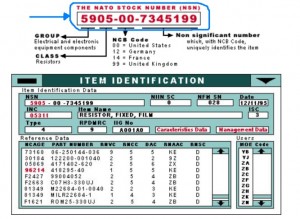 شكل 4- 1- اطلاعات شناسايي قلم كد NSN
شكل 4- 1- اطلاعات شناسايي قلم كد NSN
چنانكه مشاهده میشود اين كد داراي سه بخش ذكر شده (گروه و كلاس طبقهبندی، كد NCB و شماره سريال) است و از آنجا كه كد NCB آن 00 است يعني كشور طراح قلم كالا آمريكا است. كد طبقهبندی 5905 در سيستم NSC معرف گروه 59 با عنوان قطعات تجهیزات برق و الکترونیک و كلاس 05 با عنوان مقاومتها است. به عبارتي كد 7345199-00-5905 يك كد NSN است كه معرف مقاومت ثابت (بستر ثابت) كشور آمريكا است.
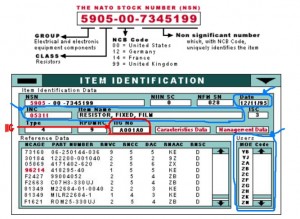 شكل 4- 2- جدول شناسايي: نام قلم، تاريخ و كد مصرف كننده و…
شكل 4- 2- جدول شناسايي: نام قلم، تاريخ و كد مصرف كننده و…
در جدول شناسايي قلم كالا( شكل 4-2) تاريخ ايجاد كد، نام قلم كالا، كد نام قلم كالا، اطلاعات مرجعي و كد اعضاي مصرفکننده ذكر شده است.
طبق سيستم كدگذاري ناتو يك قلم به دو شكل شناسايي میشود:
- شناسایی اقلام توصیفی مطابق با راهنمای شناسایی قلم (FIIG) بر اساس مشخصات ویژگیهای فنی مواد
- شناسایی اقلام مرجعي بر اساس کد کارخانه سازنده، NCAGE و شماره شناسایی اقلام سازنده (شماره فني)
اطلاعات مرجعي ثبت شده در جدول شكل 4-3 روش شناسايي مرجعي اقلام است. در اين روش قلم کالا با نام تولیدکننده و شماره شناسایی که تولیدکننده به آن تخصیص داده است شناسایی میشود. منظور از شماره شناسایی تولیدکننده، شماره قطعه یا شماره مدلی است که یک تولیدکننده بهوسیله آن یک قلم کالای تولیدی را به شکل منحصر به فرد در سیستم داخلی خود شناسایی میکند. در قسمت اطلاعات مرجعی شکل 4-3 کد NCAGE و پارتنامبر دیده میشود. کد NCAGE کد 5 رقمی منحصر به فردی است که توسط سیستم کدگذاری ناتو به تولیدکنندگان داده میشود و هر تولیدکننده با این کد شناسه منحصر به فرد شناسایی میشود. پارتنامبر معرف شماره شناسایی تولیدکننده در سیستم داخلی وی است. چنانكه مشاهده میشود مقاومت ثابت مورد نظر، تولیدکنندگان متفاوتی دارد. جهت سهولت در سفارش و خرید، کدهای همه این تولیدکنندگان به همراه شماره قطعهای که در سیستم داخلی خود استفاده میکنند، در کاتالوگ کد NSN مقاومت مورد نظر قرار گرفته است.
در این شکل کدهای دیگری نیز مشاهده میشوند که در کاتالوگ تعریف شدهاند به عنوان مثال در خصوص کد RNVC در کاتالوگ نوشته شده است:
Reference Number Variation code (RNVC
indicating whether the cited Reference Number is or is not item
identifying or is for information only;
کد تغییرات شماره مرجع: نشان میدهد که آیا شماره مرجع ذکر شده است یا فاقد آیتم شناسایی است و یا فقط برای اطلاعات است.
در واقع ثبت اعداد مختلف در پاسخ به این کد معرف هر یک از سه حالت شرح داده شده است. این کد بیان میکند که كد درج شده در قسمت پارتنامبر شامل چه نوع اطلاعاتي است PN، RN، شماره نقشه فني و غيره. به همین ترتیب کد (RNCC)، شماره نوع مستندات فني است. چنین تعریفی را برای هر یک از علائم و کدهای موجود در کاتالوگ میتوان دید.
در کاتالوگ جداول دیگری نیز دیده میشوند که توضیح داده میشود:
مطابق شکل 5 تعریف گروه و کلاس مرتبط با کد NSN ارائه میشود تا ابهامی در شناسایی محدوده کاربری قلم کالا وجود نداشته باشد.
در این جدول تعریف جامع قلم کالا ارائه شده است. ارائه این تعریف نیز به مانند ارائه تعریف گروه و کلاس طبقهبندی به منظور شناسایی صحیح قلم کالا صورت گرفته است.
با انتخاب هر NCAGE جدولی مانند شکل 7 مشاهده میشود که مشخصات سازنده شامل نام، آدرس، محل كشور، شماره تماس و آدرس سايت ارائه میشود.
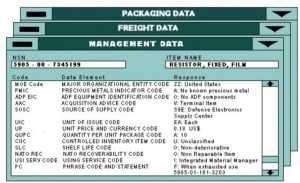 شکل 8- داده مشخصاتی (مشخصات فنی)
شکل 8- داده مشخصاتی (مشخصات فنی)
مهمترین بخش هر کاتالوگ ارائه مشخصات فنی است. چنانکه شرح داده شد مشخصات فنی هر قلم کالا باید مطابق راهنمای شناسایی قلم فدرال ارائه شود. چنانکه در شکل 4-2 مشاهده میشود شماره IIG (همان FIIG) درج شده است که A001A0 است. این راهنما مشخص میکند برای مقاومت ثابت مورد نظر چه مشخصاتی باید قید شود شکل 8 نشانگر مشخصات فنی مقاومت ثابت مطابق IIG A001A0 است. برای هر مشخصه معرفی شده هم علامت مشخصه هم تعریف آن نمایش داده شده سپس ارزشهایی (پاسخها) که معرف مقاومت ثابت مورد نظر است درج شده است. این مشخصات طبق IIG و پاسخها به شکل استاندارد شده توسط اعضاء خصوصاً کشور طراح (در این کد خاص کشور آمریکا) ثبت شده است. تمامی تولیدکنندگانی که در شکل 4-3 لیست آنها مشاهده شد به شرط تطابق محصول با مشخصات درج شده در شکل 8 میتوانند تأمینکننده ناتو باشند.
این روش شناسایی توصیفی است که وابستگی به تولیدکنندگان و روش شناسایی داخلی آنان ندارد. در این روش مستقل از اینکه قلم کالا از چه تولیدکننده یا چه کشوری تأمین میشود، قابل شناسایی است.
در کاتالوگها همچنین جداول دیگری وجود دارند كه اطلاعات بيشتری در خصوص محصول را ارائه میدهد. جداولي مانند اطلاعات بستهبندی، اطلاعات مديريتي (عوارض گمركي، كشور مبدأ، وجود فلزات گرانبها و…)، اطلاعات حملونقل، شرايط نگهداري و غيره از اين دست هستند. نتیجهگیری
سیستم کدگذاری ناتو سیستمی مبتنی بر طبقهبندی است. مطلوب ناتو از این سیستم کدگذاری مدیریت تدارکات، آماد و لجستیک است. برای ناتو صاحب کالا یا اطلاعات مرجع در تأمین نیازهای نظامی در درجه اهمیت قرار ندارد. تأمین به موقع و صحیح اقلام مورد نیاز از هر کشور و تولیدکنندهای در دنیا با هر زبان و ملیتی اولویت این سیستم است. در واقع در تدارک یک قلم کالا و انتقال آن از یک انبار به انبار دیگر یا قسمتی به قسمت دیگر آنچه برای کاربر نهایی اهمیت دارد طراحی، عملکرد و کیفیت قلم کالا است نه اینکه چه کسی آن را تولید کرده است؛ بنابراین وجود یک سیستم کدینگ بر مبنای شناخت ماهیتی قلم کالا الزامی است. ناتو با این سیاست از سیستم کدگذاری دارای طبقهبندی استفاده ميكند نه کدینگ بیمعنی. این سیستم در نهایت باید بتواند به تولیدکنندگان مرتبط شود یعنی با استفاده از این سیستم در نهایت باید سفارش و خرید اتفاق بیفتد. در این راستا سیستم کدگذاری ناتو با ایجاد کاتالوگ، مشخصات فنی و ارزشهای استاندارد شده، شناسایی تولیدکنندگان اقلام منطبق با مشخصات درج شده در کاتالوگ و نهايتا اتصال کدهای NSN به شماره مرجع یا شماره فنی سیستمهای داخلی تولیدکنندگان توانسته یک بانک کامل و جامع برای هر قلم کالا فراهم کند که تولیدکنندگان مطابق با استانداردهای ناتو، اقلام تولیدی خود را معرفی و شناسایی کنند.
با این بستر سفارشها و تأمین لجستیک ناتو بهراحتی، به شکل منسجم و بدون خطا صورت میپذیرد. این سیستم همچنین تنوع اقلام را کاهش داده امکان نظارت و گزارشگیری را برای مدیریت تدارکات ناتو فراهم میکند. کاتالوگها و هندبوکها (مانند H6) زبان مشترک را بین اعضای ناتو، تأمینکنندگان و مصرفکنندگان فراهم میکند.
این مقاله سعی در تبين این واقعيت دارد که بیمعنی بودن یا نبودن کد نمیتواند نشانگر ضعف یا قوت آن باشد. آنچه لزوم استفاده از یک نوع سیستم کدینگ را مشخص میکند، دامنه کاربرد يا قشر هدف آن است. در تمامی کشورها از سیستمهای کدگذاری معنیدار برای ارتباط مؤثر بین ارکان زنجیره تأمین استفاده میشود. بعضی از کشورها برای رفع نیاز خود در این بخش با آنکه عضو ناتو نیستند، اما از سیستم طبقهبندی آن استفاده میکنند.
بعضی از کشورها با آنکه عضو ناتو هستند اما برای مدیریت نیازهای داخلی خود به سیستم کدگذاری دقیقتری نیاز دارند لذا به سیستم ناتو اکتفا نکرده در بخش مورد نیاز اقدام به ایجاد طبقهبندی و کدگذاری کردهاند.
در ایران در پی نیاز به شناسایی اقلام برای مدیریت زنجیره تأمین، کدهای معنیدار طراحی و استفاده شدند. این سیستم نتیجه یک تلاش و سرمایهگذاری ملی و منطبق با شرايط داخلي كشور است و نباید مزایای کدهای بیمعنی سبب شود ارزش و اهمیت کد ملي نادیده گرفته شود. در واقع کاربردهای مورد انتظار از يك سيستم كدگذاري است که نوع آن را مشخص ميكند.
مرکز ملي شمارهگذاری کالا و خدمات قادر به ارائه کدهای مختلف متناسب با نیاز اعضا یا مشترکین اطلاعاتی است و در راستاي سهولت كدگذاري و شناسايي كالا در مبدأ و همچنین توليد دادههای با كيفيت اقدام به ارائه اطلاعات و تعاريف استاندارد شده كرده است كه براي اعضا و مشتركين اطلاعاتي قابل دسترسي است.

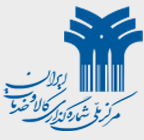




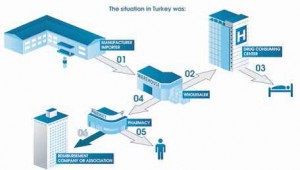



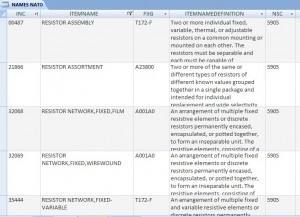

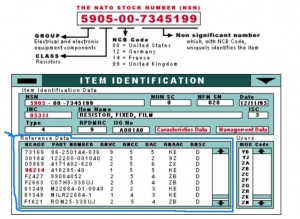


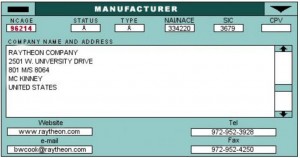
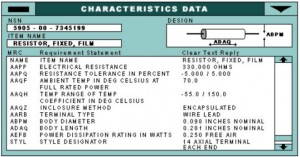
 صاحب امتياز
صاحب امتياز